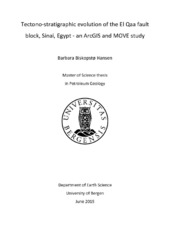Tectono-stratigraphic evolution of the El Qaa fault block, Sinai, Egypt - an ArcGIS and MOVE study
Master thesis
Permanent lenke
https://hdl.handle.net/1956/10409Utgivelsesdato
2015-06-01Metadata
Vis full innførselSamlinger
- Department of Earth Science [1050]
Sammendrag
The Gulf of Suez is a classic example of a failed rift system and due to the extensive erosion it has become perfect for studying structural style and stratigraphy in a 3D environment, where the sedimentary architecture can be studied in more details. There have been many studies in specific areas within the Gulf of Suez focusing on these subjects, but less focus has been on construction and restoration of cross-sections and 3D modelling in the area, which is the focus of this study, in addition to a geological map generated in this thesis. The work in this study includes the mapping of prerift and synrift units, faults, folds and dip data and an analysis of the tectono-stratigraphic evolution of the El Qaa fault block. The geological map is generated in ArcGIS by mapping lithological boundaries, tracing faults and folds and adding dip data. Based on the geological map, six cross-sections were constructed and restored using the 2D/3D MOVE software and the interpreted cross-sections are used to construct a 3D model of the present day structural style in the El Qaa fault block. The tectono-stratigraphic evolution can be divided into 4 main synrift stages. Synrift stage 1 (Burdigalian-Langhian) is the first rotation of the prerift units that caused an angular unconformity between the prerift and synrift units. Synrift stage 2 (Langhian) is a further rotation of the units as the Rudeis Formation and the Delta Lope complex 1 was deposited. Synrift stage 3 (Seravallian) contains the deposition of the Delta Lobe Complex 2 and 3. Synrift stage 4 (Seravallian-Present day) is the latest rotation of the units caused by the increased displacement on the Coastal Fault Belt as the fault activity in the rift migrates towards the rift axis. The lower Delta Lobe Complex 1 is a short, steep and coarse-grained delta with a local catchment-area that is feeding the delta with sediments derived from the uplifting rift shoulder on the East Boundary Fault Belt. The Delta Lobe Complex 1 is deposited in similar structural settings as the much smaller western delta in the Alkyonides half graben in the Gulf of Corinth which has a high subsidence rate and high accommodation development. The upper prograding Delta Lobe Complex 2 and 3 are deposited in a more tectonically quiet period, with a low subsidence rate and low accommodation development, it extends ca. 13,5 across the El Qaa half graben. The upper deltas show similarities with the deltas on the Horda platform containing the Krossfjord, Sognefjord and Fensfjord Formations, in being larger and possible having a well-developed catchment-area feeding the deltas. The study illustrates the importance of understanding how the sedimentary architecture in a rift basin is formed and the main factors controlling the sediment dispersal.
